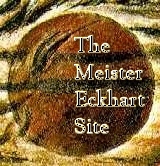|
|
||
 |
Meister Eckhart Home / Works by Meister Eckhart - Quotes / Inspired by Eckhart / Studies / The Papal Condemnation / Mail & Announcements / Links / Books |
ERNST TROELTSCH
From:
Ernst Troeltsch, The social teaching of the Christian
Churches, v. II,
tr. Olive Wyon, 1931, pp. 730 - 741. Here published without footnotes.
Page 8
In connection with our present subject, however, all this is only relevant in so far as the relative acceptance of mysticism at that time formed the starting-point of and the justification for an ever fuller penetration of mysticism into Christianity itself. For us rather the significant effects of mysticism only emerge clearly where the sense of need for the inwardness and quickening of the religious process appropriated the technical methods of the soul's ascent to God, worked out by mysticism. This ascent was described as a process by which the soul rose from meditation and self-denial through ripening knowledge and union, to the heights of ecstasy, and thus was able to attain and experience Christian union with God and with Christ. Here Dionysius the Areopagite forms not the only but the noblest bridge of union with the Neo-Platonism which had most thoroughly formulated this doctrine. The Alexandrian theologians and Augustine had also already made their contribution. The decisive point, however, was not reached until mediaeval piety accepted the traditional Christian system, with its foreign elements inherited from antiquity (so remote from the Germanic temperament) of cultus, doctrine, and hierarchy; this it did by way of mysticism, which breathed into it an atmosphere of warm, personal piety. Thus St. Bernard and the Victorines freed the Christian faith from dogmatic rigidity and infused into it new warmth and vigour. Thus also the mystics of the Reformation period describe the gradual ascent of the soul from purgation, through illumination, right up to the heights of blissful union with God.
Further, we must also note the doctrine of mystical union with God or of the Indwelling of Christ as the very heart and basis of all practical religious achievement, and the radiating centre of religious ethics. Along these lines Christian mystics have sought and found a substantial union with Christ, in which the Christian experience became the principle of all religious activity and power, and, on the other hand, practical power to overcome the world became the test of the reality of union with Christ. In this way the gulf between past and present, between doctrine and practice, was overcome, and faith became the principle of direct practical achievement. Thus the Christocentric piety of the Middle Ages restored to believers direct access to Christ; the rock of Byzantine dogma had been struck, and out of it there flowed rivers of living water.
Luther also, sometimes revealed traces of this spirit, and it was through these ideas that Karlstadt, Schwenkfeld, and Osiander developed a mere faith in the doctrine of justification into the power of a life which expressed itself outwardly in direct and practical ways. This, too, was the tendency of the Christology of all the "spiritual reformers" of that day; it enabled them to interpret the Jesus of History and the mystically discerned Christ of Experience by the more general principle of the Logos incarnate in Christ, through whom they were brought into contact with the eternal living fullness of God.